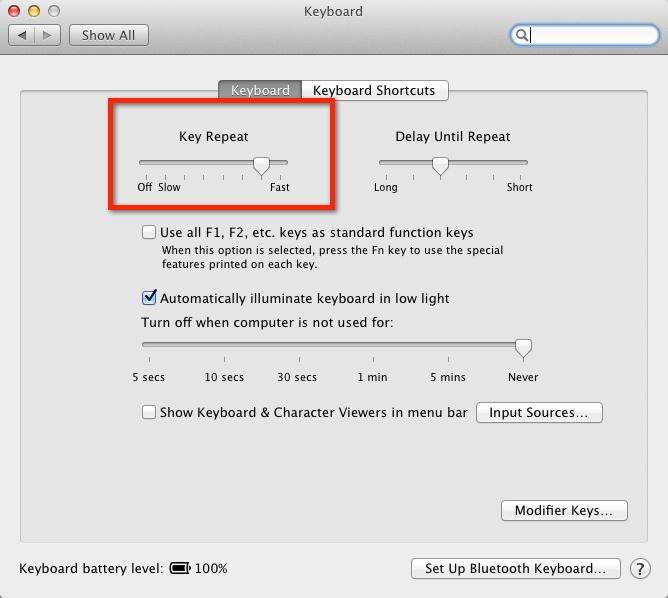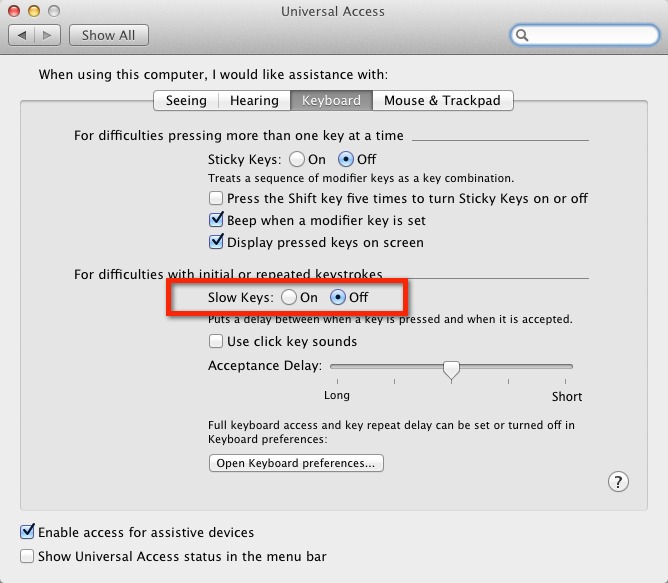Mac key convention: ' Ctrl ' is used for 'Control', ' Apple ' is used for 'Command' and ' Alt ' is used for the 'Option' key.
Note: For keyboard access, make sure ' Full keyboard access ' is turned on - you can turn it on or off; by pressing ' Ctrl' + ' F1 ' at any time.
Step 1
Keyboard settings
Make sure you are in ' Finder ' - press ' Apple ' + ' Tab ' if necessary to cycle through open applications until you return to ' Finder '.
- Click on the 'Apple ' menu or press ' Ctrl ' + ' F2 '.
- Click on ' System Preferences... ' as shown in Fig 1 or press the down arrow key to highlight it and then press ' Enter '.

Fig 1
Step 2
Keyboard
There are two keyboard setting you can adjust to help you with your typing, the ' Key Repeat Rate ' setting changes the rate at which a key repeats when it is held down and the ' Delay Until Repeat ' setting changes the delay before a key starts repeating when it is held down.
- Click on the 'Keyboard ' icon or press ' Tab ' repeatedly (you might need to press ' Ctrl ' + ' F7 ' first) to cycle through the icons until the ' Keyboard ' icon is highlighted and then press the ' Spacebar '. Fig 2

Fig 2
- Click on the ' Keyboard ' tab or press ' Ctrl ' + ' F7 ' (once or twice) to highlight one of the tabs and then press the left or right arrow key to select the ' Keyboard ' tab.
- To change the rate at which a key repeats when it is held down click on the ' Key Repeat Rate ' gauge bar to select a more comfortable repeat rate, or press ' Tab ' to highlight the ' Key Repeat Rate ' gauge bar 'slider' and use the left and right arrow keys to select your speed. Fig 3
- To change the delay before a key starts repeating when it is held down click on the ' Delay Until Repeat ' gauge bar to select a more comfortable repeat rate, or press ' Tab ' to highlight the ' Delay Until Repeat ' gauge bar 'slider' and use the left and right arrow keys to select your speed. Fig 4
- When you are happy with your changes click the ' Close ' (red) button at the top of the ' Keyboard & Mouse ' window or press ' Apple' + 'W ' to close the window and return to the Finder desktop.

Fig 3
Slow Keys
'Slow Keys' enable you to tune the amount of time the computer waits, whilst you are holding a key down, before it accepts it. This means that you can press hundreds of keys by accident without the computer processing a single one, until it is held down for a specific length of time. To adjust the setting for 'Slow Keys' :
- Make sure you are in ' Finder ' - press ' Apple ' + ' Tab ' if necessary to cycle through open applications until you return to ' Finder '.
- Click on the 'Apple ' menu or press ' Ctrl ' + ' F2 '.
- Click on ' System Preferences... ' as shown in Fig 1 or press the down arrow key to highlight it and then press ' Enter '.
- Click on the 'Universal Access ' icon or press ' Tab ' repeatedly (you might need to press ' Ctrl ' + ' F7 ' first) to cycle through the icons until the ' Universal Access ' icon is highlighted with a blue border and then press the ' Spacebar '.
- Click on the ' Keyboard ' tab or press ' Ctrl ' + ' F7 ' (once or twice) to highlight one of the four tabs for example ' Seeing ' and then press the left or right arrow key to select the ' Keyboard ' tab. Fig 4

Fig 4

- To turn on ' Slow Keys ' click on the ' On ' radio button next to ' Slow Keys: ' or press ' Tab ' until the ' Off ' radio button is selected and then press the left arrow key to turn on ' Slow Keys '.
- As standard a click sound is heard when you hold down the key, to turn it off uncheck the ' Use click Key sounds ' box or press ' Tab ' to highlight it and press the ' Spacebar '.
- You can also change how long you need to hold down a key before it registers by changing the acceptance delay. To do this click on the ' Acceptance Delay: gauge bar to lengthen or shorten the delay or press tab until the ' Acceptance Delay: gauge bar 'slider' is highlighted and then press the left or right arrow key to lengthen or shorten the delay.
Step 3
- When you are happy with your changes click the ' Close ' (red) button at the top of the ' Universal Access ' window or press ' Apple' + 'W ' to close the window and return to the Finder desktop.
Note: If this does not work it could be because your computer settings cannot be changed due to local IT policies - contact your local IT support for further help.